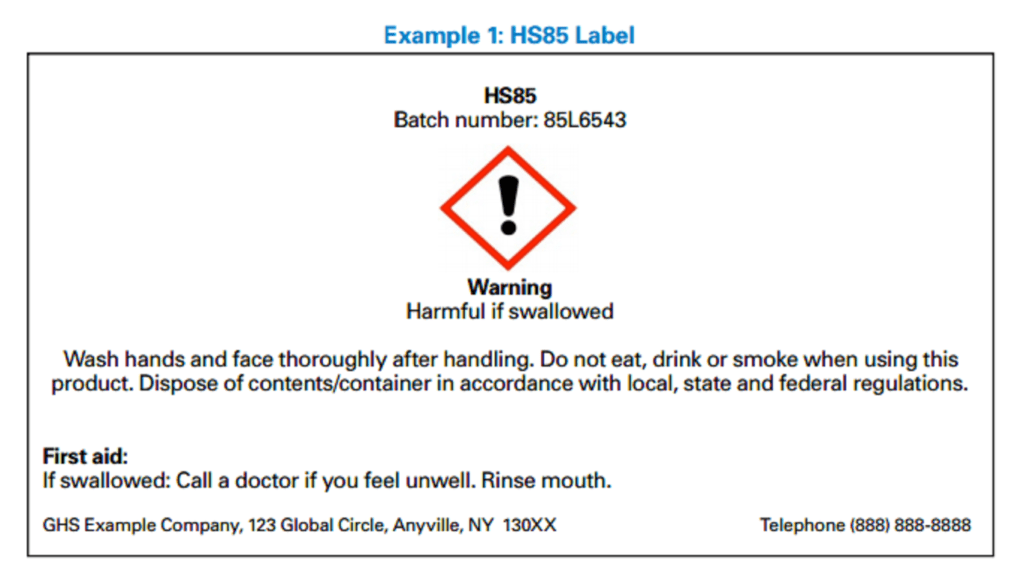Storing hazardous substances properly requires a lot more thought than just throwing a bunch of bottles and boxes in a cabinet and hiding the key. Some substances cannot be stored at certain temperatures, some cannot be stored near each other, and some are too dangerous to the touch and require handlers to receive training. Whatever the hazard might be, it’s important to know proper storage procedures. It will protect your workers, your inventory, and your facilities.
Before getting into that discussion, it’s important to understand how hazardous substances are classified and labeled according to the GHS.
The GHS is an acronym for The Globally Harmonized System of Classification and Labeling of Chemicals. The GHS is a system for standardizing and harmonizing the classification and labeling of chemicals. It is a logical and comprehensive approach to:
- Defining health, physical and environmental hazards of chemicals;
- Creating classification processes that use available data on chemicals for comparison with the defined hazard criteria; and
- Communicating hazard information, as well as protective measures, on labels and Safety Data Sheets (SDS).
Source: https://www.osha.gov/dsg/hazcom/ghsguideoct05.pdf
The word “chemical” here is actually used pretty loosely. Within the Globally Harmonized System (GHS) classification criteria, the term “chemical” is used to includes the terms substances, products, mixtures, preparations or any other words used in existing systems.
Classifying Hazardous Chemicals
Classification involves assigning a chemical or mixture a category of hazard/danger using defined criteria. To break it down a step further, hazards fall under one of three categories: physical hazards, health hazards, or environmental hazards.
Physical Hazards
Explosives: Explosives are at risk of detonation due to chemical reaction.
Flammable Gases: Flammable gases have a flammable range in air at 20 degrees Celsius and a standard pressure of 101.3 kPa.
Flammable Aerosols: Here, the gas is compressed, liquefied, or dissolved under pressure in a non-refillable container with a release device.
Oxidizing Gases: Oxidizing gas is a gas that causes or contributes to combustion of other material more than air does.
Gases Under Pressure: Gases under pressure are contained at a pressure no less than 280 Pa at 20 degrees Celsius or as a refrigerated liquid.
Flammable Liquids: Flammable liquid means a liquid having a flash point of not more than 93°C. stored above that temperature in a liquid state, it will emit a flammable vapor.
Flammable Solids: Flammable solids can cause a fire through friction, spontaneously heat up when in contact with air, or are otherwise liable to catch fire or become flammable when wet.
Self-Reactive Substances: Self-reactive substances can be similar to explosives, organic peroxides, or oxidizers. They differ in that they are liquids or solids that undergo exothermic thermal decomposition even without oxygen.
Pyrophoric Solids: Pyrophoric solids can ignite within five minutes of exposure to air.
Self-Heating Substances: Solids or liquids (not pyrophoric substances) that heats up when exposed to air and without external energy supply. Self-heating substances can still ignite like pyrophoric solids, but it can take hours or days.
Substances which on Contact with Water Emit Flammable Gases: The name speaks for itself here. When wet, these substances (solids, liquids, or gases) emit a dangerous amount of flammable gas.
Oxidizing Liquid: May cause or contribute combustion of other materials.
Oxidizing Solids: May cause or contribute combustion of other materials by yielding oxygen.
Organic Peroxides: Organic liquid or solid derived from hydrogen peroxide. They are liable to explosive decomposition, burn rapidly, be sensitive to impact or friction, and react dangerously with other substances.
Toxic and infectious Substances: Toxic substances pose substantial health risk if inhaled, consumed, or comes in contact with skin.
Corrosive to Metals: Corrosive substances can degrade or disintegrate other materials on contact.
Health Hazards
Acute toxicity: Substances with acute toxicity hazards fall into 1 of five toxicity categories. Acute toxicity describes adverse effects from a single exposure to a substance: oral, dermal, or inhalation.
Skin corrosion/irritation: Skin corrosion is irreversible damage to the skin after application of a substance for up to 4 hours. Skin irritation is reversible damage after application of a substance for up to 4 hours.
Serious eye damage/eye irritation: Serious eye damage is when tissue is damage to the eye tissue, decay in vision which cannot be fully reversed after 21 days. Eye irritation is the same but is fully reversible within 21 days.
Respiratory or Skin sensitizer: Respiratory sensitizer is a substance that increases sensitivity of the airways. Skin sensitizers induce an allergic reaction after it’s been touched.
Germ cell mutagenicity: Exposure to these substances can increase mutations in cells/organisms.
Carcinogenicity: Carcinogens induce cancer or increase its incidence.
Reproductive toxicity: Reproductive toxicity encompasses adverse effects on sexual functioning, fertility, and developmental toxicity in offspring.
Target Organ Systemic Toxicity (TOST): Single Exposure & Repeated Exposure: Including narcotic effects and respiratory tract irritation, TOST include all significant health effects not otherwise specifically defined in the GHS.
Aspiration toxicity: Chemical pneumonia, pulmonary injury, and death following aspiration all fall under aspiration toxicity.
Environmental Hazards
Acute aquatic toxicity: Acute aquatic toxicity is the property of a material to cause injury to an aquatic organism in a short-term exposure.
Chronic aquatic toxicity: Chronic aquatic toxicity means the potential or actual properties of a material to cause adverse effects to aquatic organisms during exposures that are determined in relation to the lifecycle of the organism.
Labeling
Each hazardous material is required to be labelled according to the GHS. Standard elements included in the GHS are:
Symbols (pictograms)
Signal Words
There are only two signal words used in the GHS – “danger” and “warning”. Danger is used to indicate more severe hazards; warning is used to indicate less severe hazards. Some lower level hazard categories don’t use any signal words.
Hazard Statements
Hazard statements are standardized phrases associated with a hazard classification.

Source: https://www.osha.gov/Publications/OSHA3636.pdf
Training and SDSs
Workers are required to be trained to handle hazardous substances in the workplace. They should also know where to find additional information on what to do in the event of exposure. Safety Data Sheets list all of that information, and employers are required to keep them on file for each and every material on site.
How should they be stored?
Not all the hazardous substances that you have on hand will have to be stored in a specific way. As an example, your laptop and phones contain batteries that have special instructions when shipped, but we can safely keep them in our bags and pockets. When it comes to dealing with chemicals, cleaning products, paints, and other materials that are highly sensitive to their environment, they should be stored accordingly. Here are a few tips:
Do an inventory of everything you have on hand
This is a basic housekeeping tip anyway, but knowing how much of each material you have on hand will assist you with knowing what your storage needs are, if/when you need to have more on hand, and to make proper accommodations for storage.
Everything should be labeled accordingly
This is a big one that is frequently overlooked. We will discuss this in more detail below, but each hazardous material you have on hand should be marked with the proper symbols that depict the characteristic(s) of hazard and level of severity.
Know what not to store in the same vicinity
Many chemicals have specific storage requirements that state what they cannot be stored in the same vicinity with. A screw-up here could result in dangerous chemical reactions.
Be aware of the temperature at which they will be stored
If the materials you are storing are unstable at higher temperatures, make sure not to store them in direct sunlight or in a warm room.
Inspect storage areas annually
As part of your yearly inspections, give your storage areas a little TLC to make sure everything is in order. That is also a good time to verify your chemical inventory, make sure you have all the SDSs you need on hand, and clean up any messes in the area.
Keep exits and hallways clear
When you have a designated spot or spots for hazardous material storage, there must be a clear path for safe entry and exit. It must be kept clear at all times.
Keep the area ventilated
Some hazardous materials do emit fumes, so it’s important the room in which they are stored has proper ventilation. Note* Never store chemicals in fume hoods.
Where not to store things
The safest place to store your hazardous materials are in a cool a well-ventilated room with a fire proof cabinet. Do not ever store them in these places:
In a hot vehicle
It’s easy to throw an aerosol can on the dashboard of your truck while you’re out working for the day, but it’s extremely hazardous.
Outside
Storing hazardous materials where the temperature cannot be controlled is a recipe for disaster. Additionally, if any leaks were to happen, the materials would be left to creep into the ground, air, and water.
In sinks or on exposed shelving
You might think it’s ok to throw things in a sink or up on a shelf where they are out of reach. Again, temperature regulation is essential, as well as keeping workers from unnecessary exposure to hazardous materials. Invest in a solid, fire-proof cabinet. You won’t be sorry.
Need a little help with your chemical inventory? Check out our free downloadable template here!

